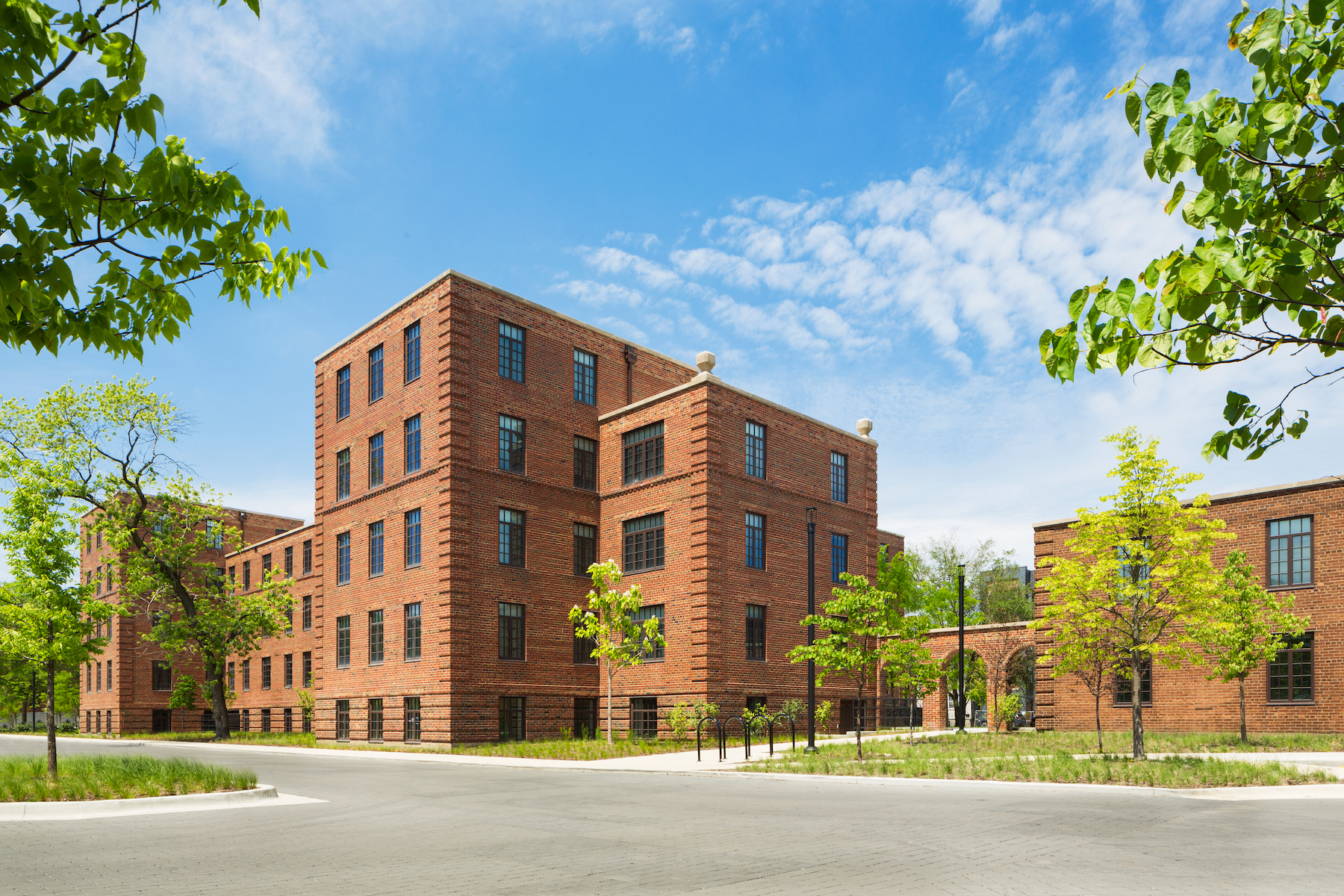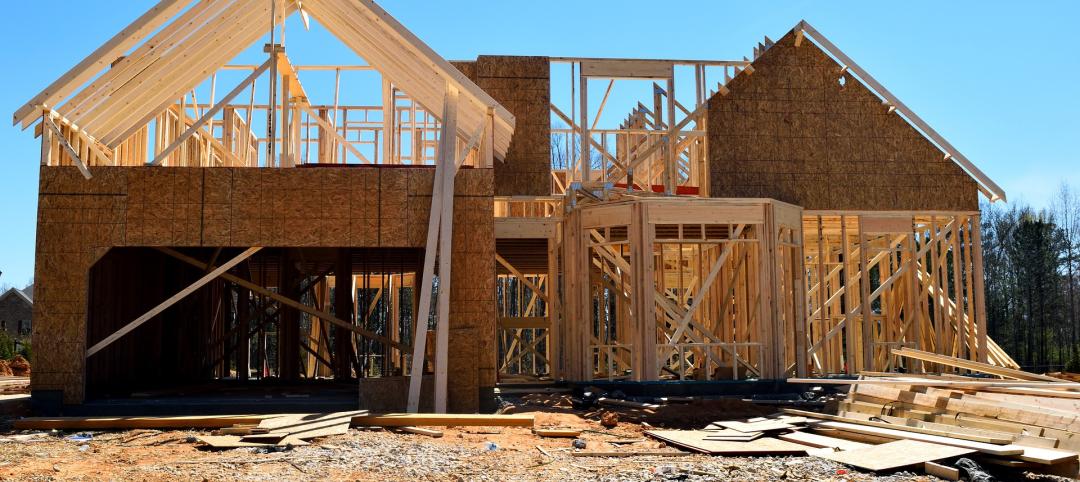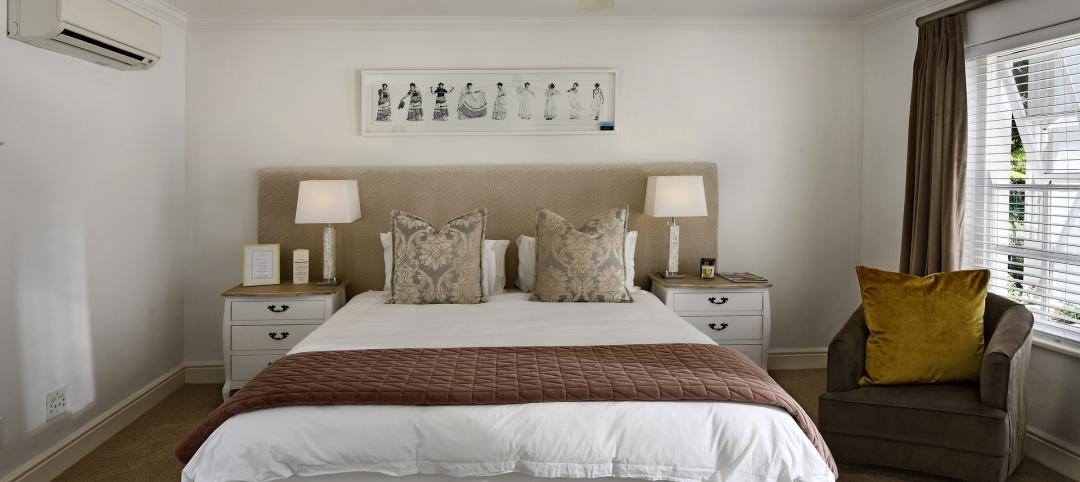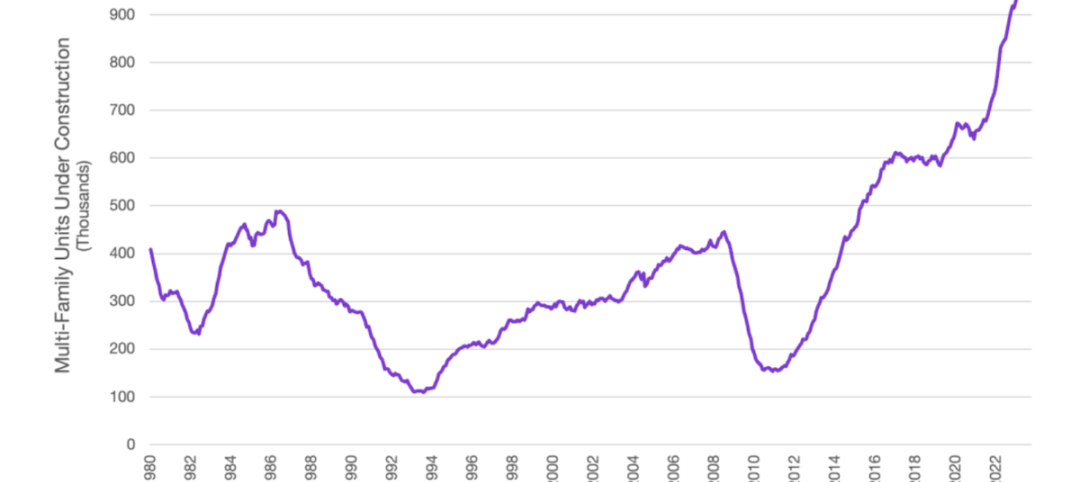On June 16, 1933, at the height of the Great Depression, Congress passed legislation creating the Public Works Administration, a key component of President Franklin D. Roosevelt’s New Deal.
The PWA’s goal was simple: to reduce unemployment—then at 25%, the highest it’s ever been—through the construction of massive public works. Out of this bold initiative would come the Grand Coulee Dam, the Lincoln Tunnel and Triborough Bridge in New York, and hundreds of courthouses, post offices, hospitals, and schools.
A less well-known piece of the PWA’s work was the construction of 52 low-rent housing projects in the U.S., the Virgin Islands, and Puerto Rico. This was the federal government’s first direct effort at building housing, a task previously left to the states, cities, and philanthropies.
The fourth-largest of these PWA public housing communities was Lathrop Homes—29 low-rise residential structures, a power station, and an administration building nestled on 34 acres along the Chicago River, on the city’s North Side. The 925-unit community opened in 1938.
Ten years ago, after decades of neglect by the Chicago Housing Authority that left just 140 of the apartments occupied, the CHA issued an RFP to consider the future of Lathrop Homes—described as “one of the most architecturally significant surviving projects from America’s first phase of public housing.”
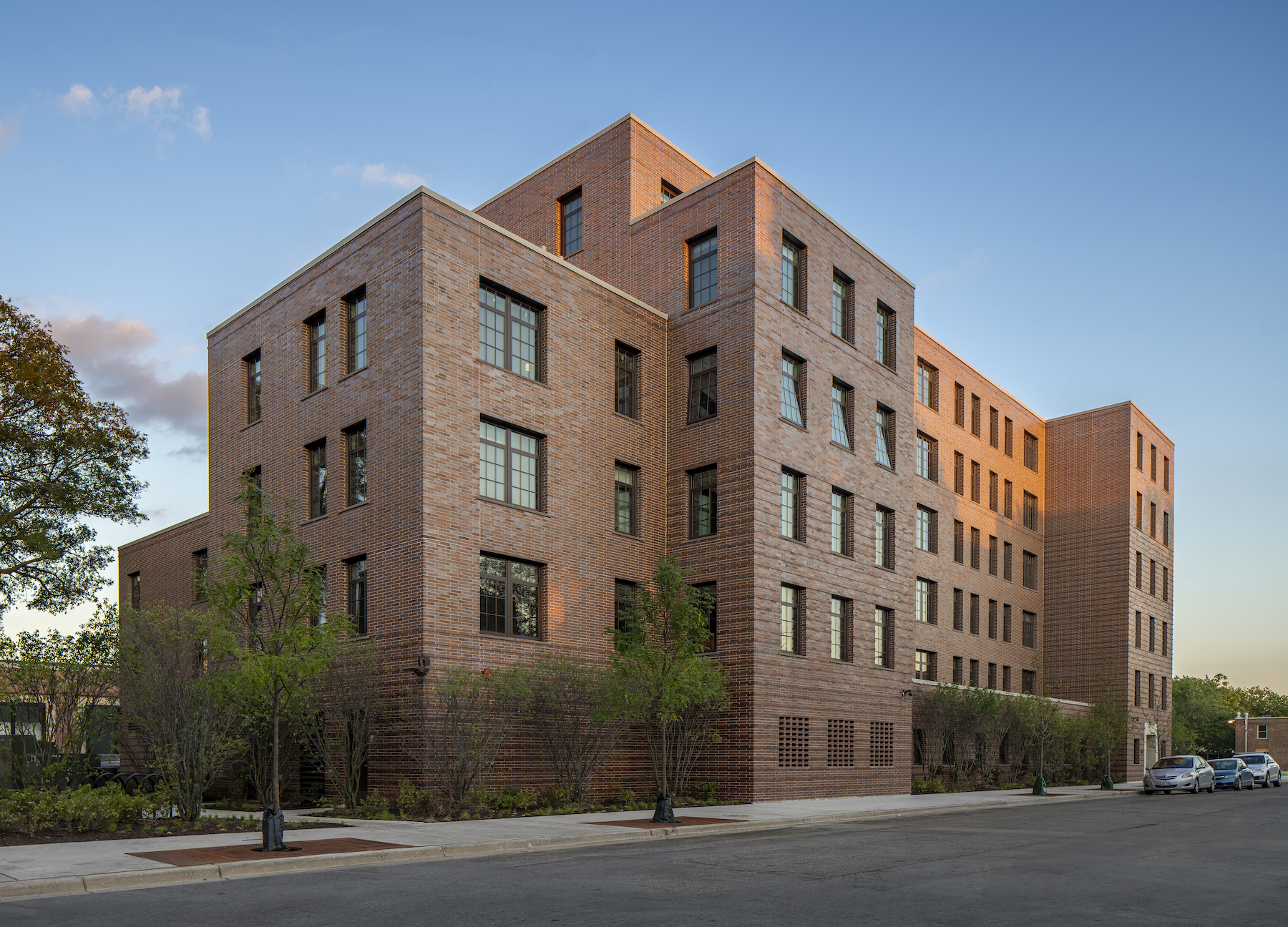
From this would emerge a plan to renovate and modernize 21 of the historic buildings, construct 12 new apartment buildings, preserve 17 acres of open space, create new linkages to the Chicago River, and add a robust menu of amenities. The Lathrop complex would eventually have 400 public, 232 affordable, and 494 market-rate housing units.
Phase 1A, completed two years ago at a cost of $200 million, saw the gut renovation of 16 of the historic buildings and construction of a new six-story structure, yielding a total of 414 apartments—151 public housing units, 91 at 60% AMI, 10 at 80% AMI, and 162 market-rate. Phase 1B, the $40 million renovation of two more historic buildings, is under way.
All units, whether public housing, affordable, or market-rate, are furnished with the same quartz kitchen countertops, Whirlpool stainless steel appliances, in-unit washer/dryers, Moen plumbing fixtures, and wide-plank flooring.
Amenities include a half-mile riverwalk and nature trail, a dog park, a children’s playground, bicycle storage, valet trash removal and recycling, maker spaces, 239 parking spaces, and a dock and kayak launch. There’s a woodshop collective on site. An independent Boys & Girls Club occupies private space at the edge of the property.
Eleven acres of open space, including the original two-acre Great Lawn, were carefully restored along historic guidelines by Michael Van Valkenburgh Associates, designers of Maggie Daley Park and The 606 trail in Chicago. MVVA added a kayak launch and circular dog park and improved connections to the Chicago River, turning what was once an eyesore into a community asset.
The massive undertaking, now known simply as Lathrop, will take years to complete. But before we go further, let’s step back for some historical perspective.
GARDEN CITIES AND PUBLIC HOUSING IN AMERICA
Lathrop Homes was designed by a team of PWA architects and engineers led by Robert Seeley De Golyer (1876-1952), a Chicago architect known primarily for designing hotels and luxury residential high-rises like The Powhatan and 1242 North Lake Shore Drive.
De Golyer’s team took their cue from Clarence Stein and Henry Wright and their associates at the Regional Planning Association of America (among them, social theorist Lewis Mumford), who in turn owed a debt to Ebenezer Howard and his 1898 book, Garden Cities of To-morrow.
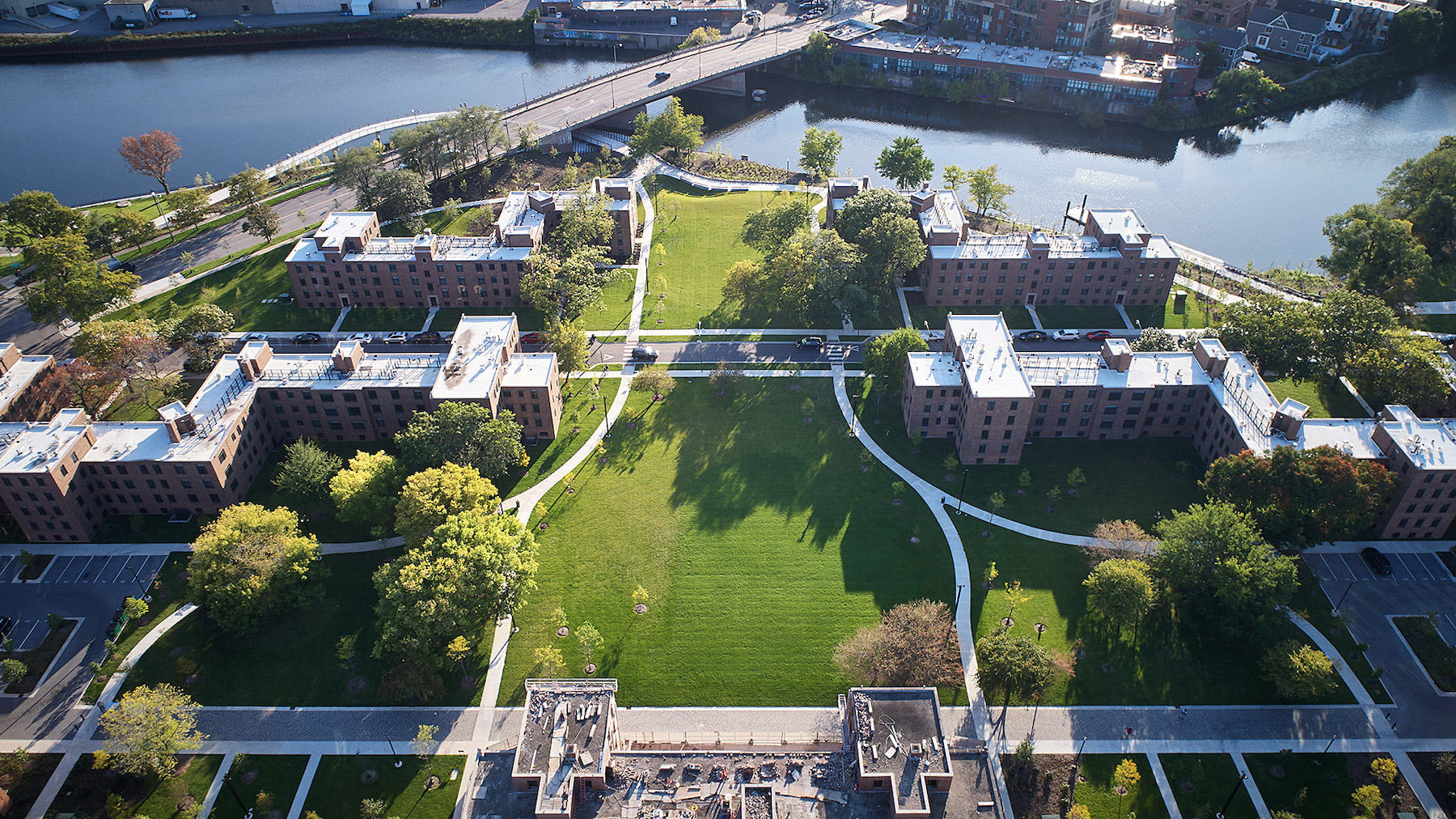
In the 1920s, Stein and Wright built Sunnyside Gardens, in Queens, N.Y., and Radburn, N.J., two such “garden cities,” which were characterized by low-scale, durable buildings, an abundance of open space, restrictions on automobile traffic, and outdoor play areas, all in the cause of promoting healthy, family-oriented communities.
Stein and Wright’s work came to fruition in 1935, when the newly established federal Housing Division issued a guidebook for PWA projects based heavily on RPAA principles.
Unit Plans, a guide to “typical room arrangements, site plans, and details for low-rent housing,” set the design framework for Lathrop Homes’ three types of living spaces: apartments (stacked, single-height units with an entry off the stair landing); row houses (two-story units with private front and rear entrances; living room and kitchen on the first floor, bedrooms and bath on the second—considered the most desirable by tenants); and a few flats (one-story units with one entrance in the front—considered the least desirable residences).
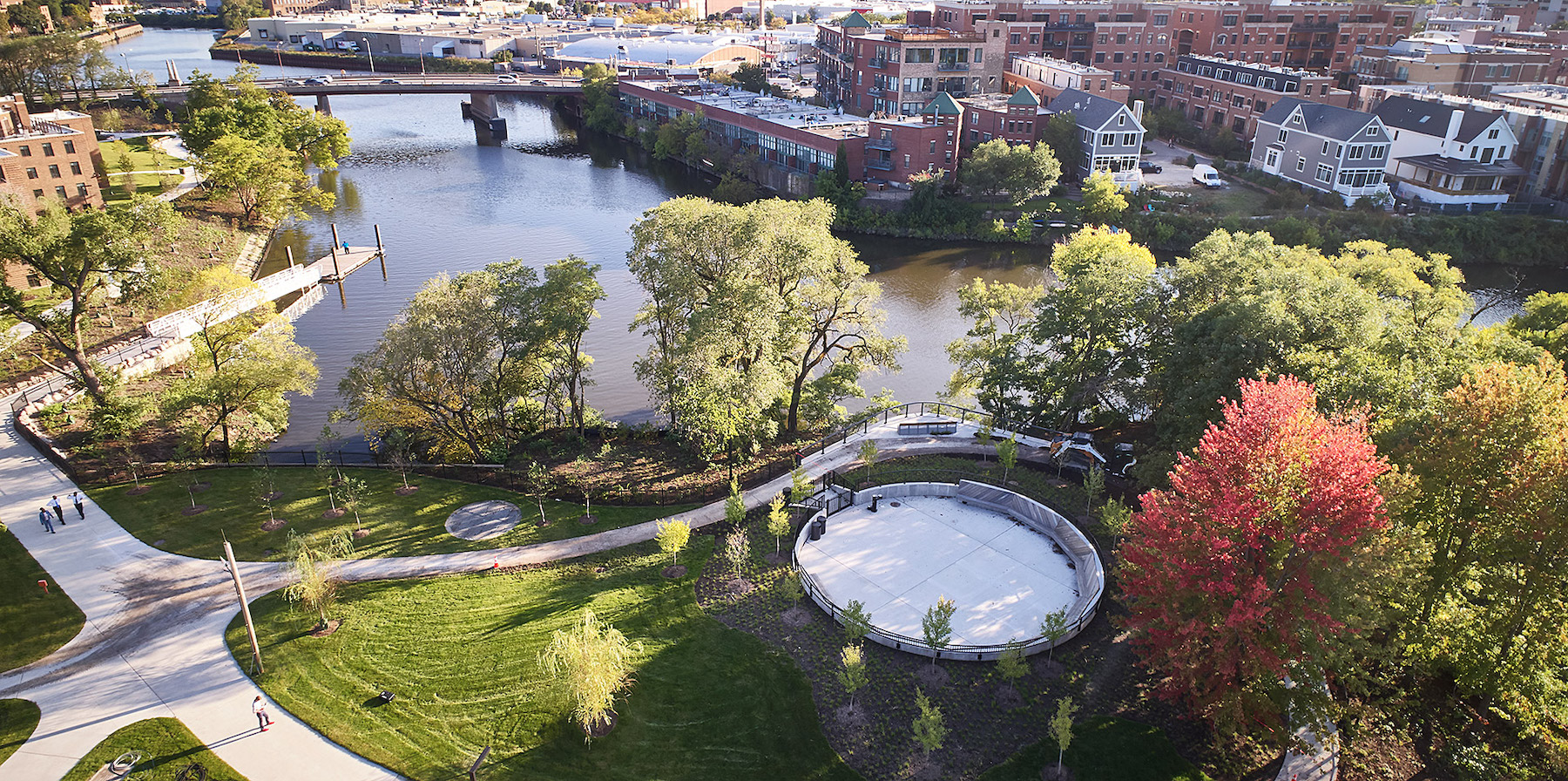
As the National Park Service would later note, this created “a united, but remarkably varied assemblage” of “simple, durable, functional, and easy to maintain” living spaces.
De Golyer hired Jens Jensen (1860-1951), the famed Danish-American landscape designer, who took an abandoned International Harvester industrial site and created 17 acres of open space—including the Great Lawn—as well as “kitchen gardens” at the rear of ground-floor apartments, where tenants could raise their own produce.
As the National Park Service would note years later, Lathrop Homes was among “the most significant projects of this period, distinguished by a well-executed site plan, as well as buildings singular in their traditional design elements and level of ornamental complexity.”
Sadly, ill-conceived housing policy at the national level and administrative incompetence at the municipal level would threaten Lathrop Homes’ standing as a paragon of PWA housing.
CHA BUNGLING, THEN A ‘PLAN FOR TRANSFORMATION’
The national program of slum clearance and urban renewal after World War II produced high-rise monstrosities like Robert Taylor Homes and Cabrini-Green, notorious for their extreme concentration of poverty, crime, and gang violence. At the same time, relatively stable public housing like Lathrop Homes suffered from chronic neglect by the CHA, to the point where, in 1995, the federal government seized control of the authority.
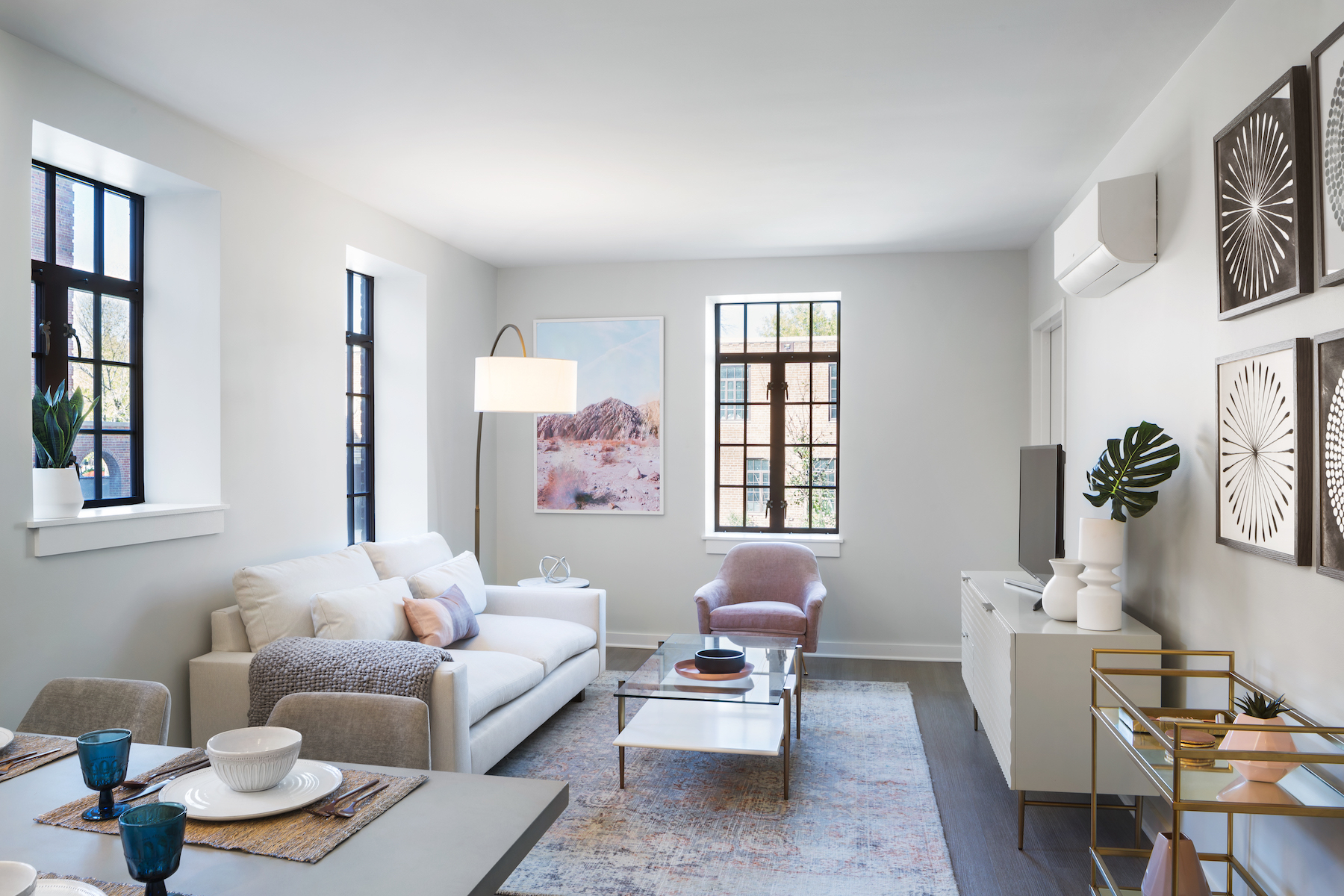
In 2000, the CHA issued a “Plan for Transformation,” which called for the demolition of 14,000 CHA apartments, including those at Robert Taylor Homes and Cabrini-Green, and the construction or renovation of 25,000 public housing units. A decade later, the CHA issued the RFP for Lathrop Homes.
‘A COMPLICATED , LONG, YET REWARDING PROCESS’
“Lathrop was as complicated and long a process as any high-rise we’ve ever done, yet so rewarding. We were involved for years before we put a shovel in the ground,” said Ann Thompson, AIA, Executive Vice President of Architecture and Design at Related Midwest, which, with nonprofits Bickerdike Redevelopment Corporation and Heartland Housing, formed the development team, Lathrop Community Partners.
Protests and tense public meetings focused attention on Lathrop’s fate. Should all 31 buildings be torn down and rebuilt new? Should they all be preserved and renovated? Should Lathrop remain 100% public housing? Would that be financially viable?
On redevelopment, the CHA took the middle route: most of the historic buildings in the north portion of the site would be renovated, but those in the south would be demolished to make room for new buildings.
As for the tenant population, “the CHA wanted a mixed-income community—public housing, affordable, and market-rate. That was the program we were given,” said Thompson. And it was the only way the project was going to pencil out. “When you’re trying to align your financing, affordable is way different from market-rate,” she said. “You have multiple sources, all with different compliance and reporting requirements, which sometimes compete with each other.”
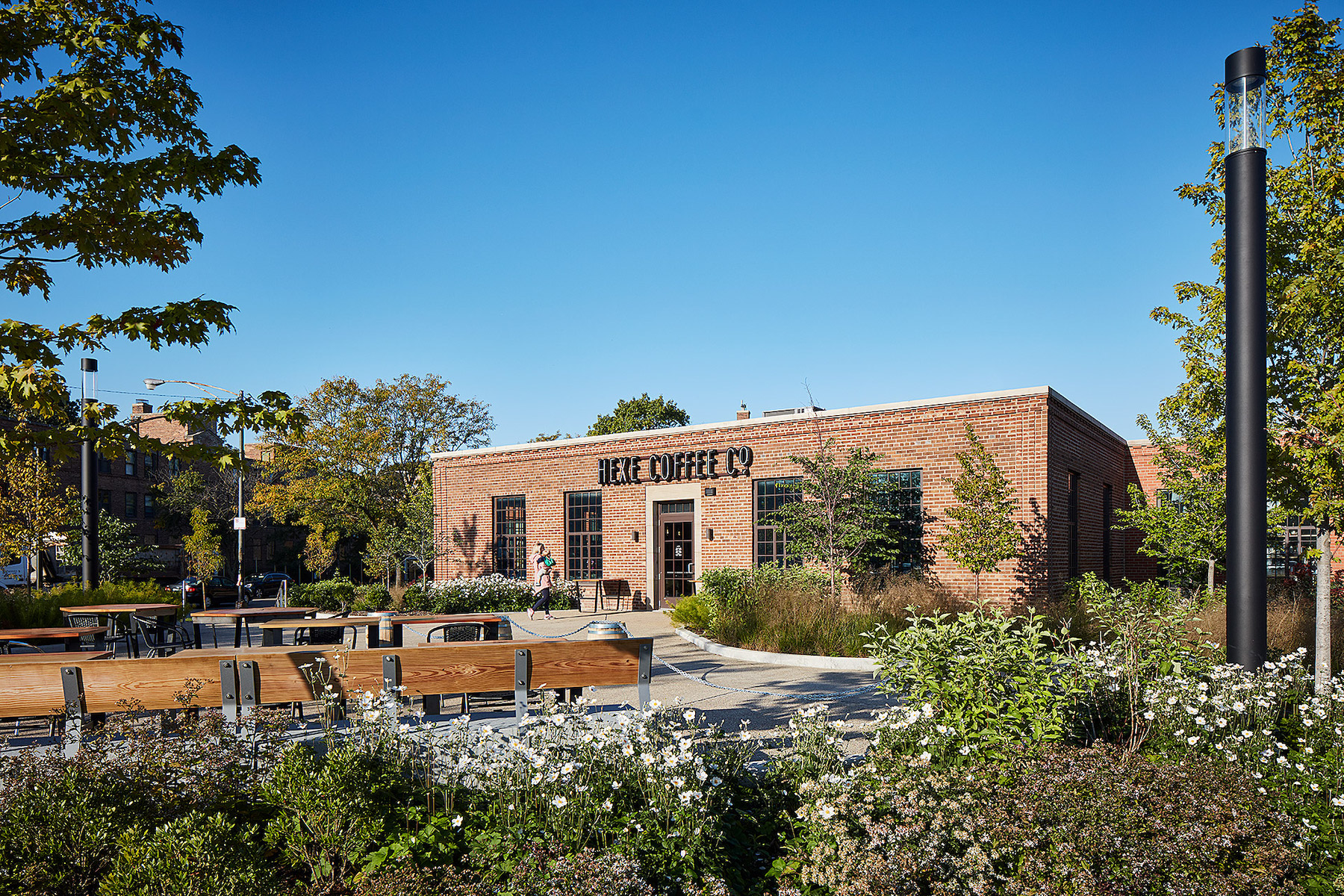
Phase 1A used eight financing mechanisms, including Low-Income, Historic, and Illinois Housing tax credits; CHA capital funds; HOME funds; a 40-year loan from the Illinois Housing Development Authority; and a 40-year Section 8 contract for the 151 public housing units.
Adding to the complexity, in 2012 the National Park Service designated the site a landmark district. Exteriors and stairwells had to meet NPS preservation standards, which sometimes led to occasionally testy discussions with the historic preservation authority. “The NPS required certain type of glass for the replacement windows, but the glass didn’t meet the energy-certification requirements we were seeking,” said Thompson. “Even the type of brick we wanted to use to patch the walls had to be negotiated.”
Achieving ADA compliance for 20% of total units posed another hurdle since accessibility was not yet a right in 1938. The lack of elevators in the historic buildings led the team to adopt a “campus-wide access” strategy: 1) renovate the ground-floor units in the historic buildings to be ADA compliant, and 2) put the rest of the required ADA units in the new six-story building, which has elevators.
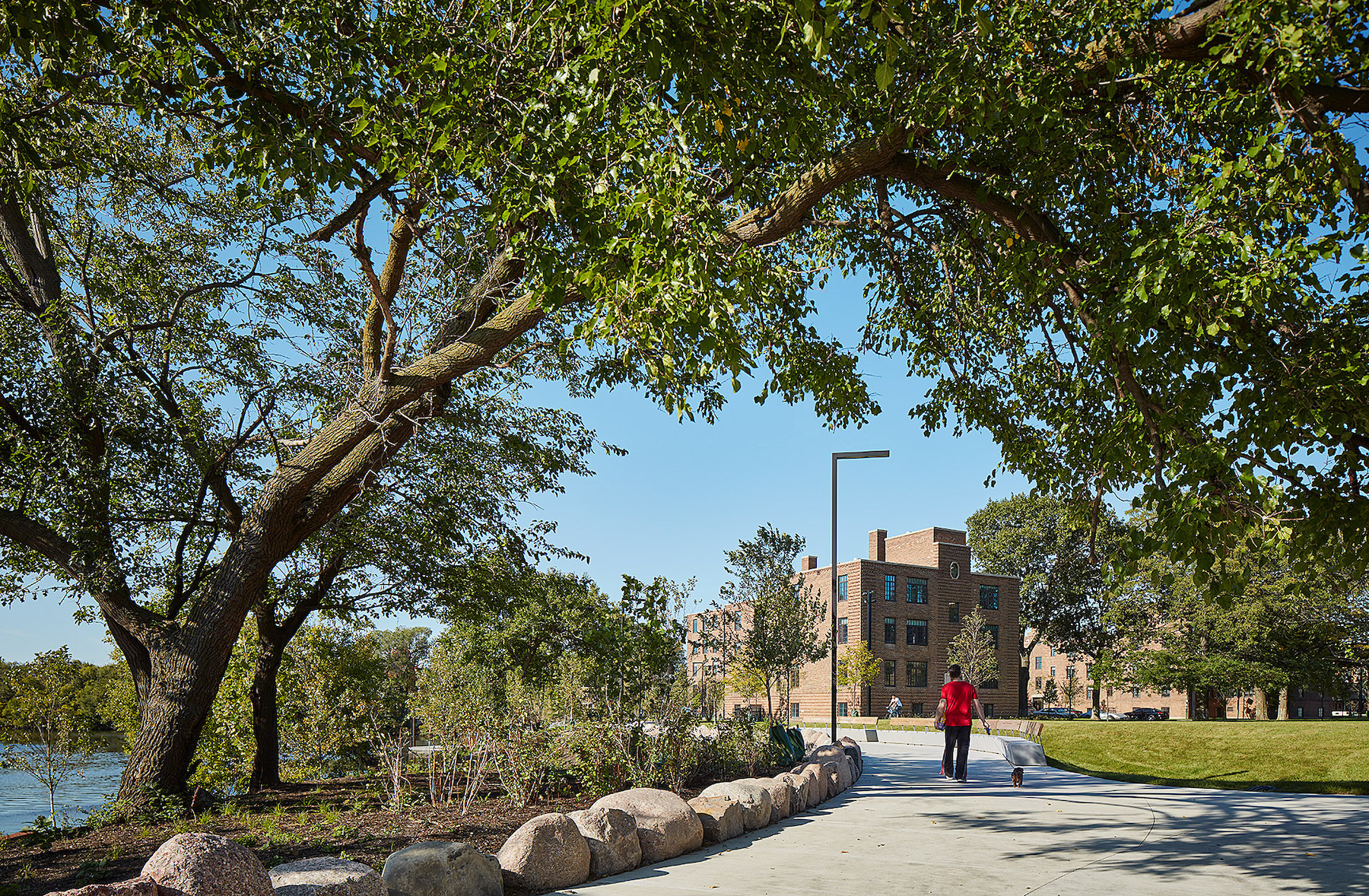
“The buildings were designed as walkups, and it would have been very tricky, if not impossible, to add elevators,” said Susan King, FAIA, LEED AP BD+C, LFA, Principal at HED, Executive Architect for Phase 1. “In terms of preserving the original character of the buildings, it’s fortunate that the campus approach was acceptable.”
ENGAGING WITH THE COMMUNITY
“Lathrop shows how important it is to engage with residents in the community,” said Thompson. She credits Related Midwest’s nonprofit partner Bickerdike Redevelopment Corporation for their outreach and resident engagement efforts. Related’s aggressive community hiring strategy led to 44% MBE/WBE participation and 48% Section 3 hires, which far exceeded what was required. She noted that Bowa Construction and MIKK Construction, the GCs on the next phase, are both minority-owned firms. (MIKK is also a WBE/DBE firm.)
“Mixed-income projects like this are very meaningful to the city of Chicago,” said Thompson. “They are complicated to do, and require a lot of patience and resilience to execute on them, but in the end, their impact lasts generations.”
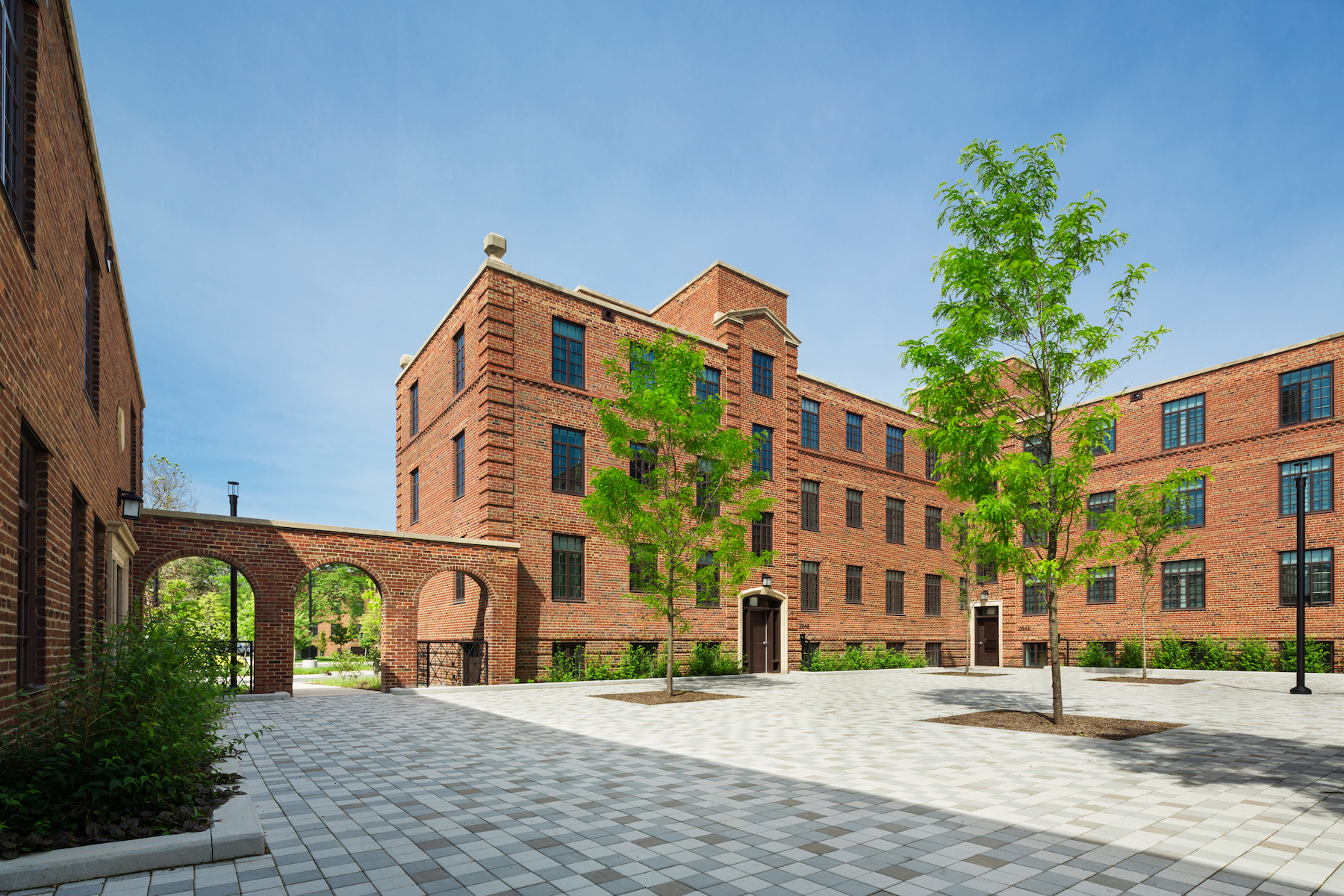
LATHROP HOMES AND THE LEGACY OF THE PWA
In the end, the Public Works Administration built just 29,000 units. Lathrop Homes remains one of its great successes, but the Lathrop of today is not the Lathrop Homes of 1938. Jensen’s kitchen gardens are gone; so, too, are most of the public housing units, replaced, out of economic necessity, by affordable and market-rate rentals. A reasonable compromise? As a nearby resident myself, I would say the overall improvements have been largely positive, but, as is always the case in this politically hypersensitive city, it depends on your perspective.
What has not been lost at Lathrop is its integral dignity and stateliness. As the National Park Service observed in designating it a landmark district, Lathrop Homes was never just a collection of buildings, but rather “a cohesive entity, designed as a unit, drawing character and strength from its consistency.” The new Lathrop preserves the refined integrity and cohesiveness of this jem of early garden-city planning, while polishing its lustre here in the 21st century. |M|
PROJECT TEAM | LATHROP
OWNER Chicago Housing Authority
DEVELOPER Lathrop Community Partners (Related Midwest, Bickerdike Redevelopment Corp., and Heartland Housing)
DESIGN ARCHITECT Juan Gabriel Moreno Architects
AOR HED (historic buildings); bKL Architecture (new building)
STRUCTURAL ENGINEER Eskenazi & Farrell Associates
CIVIL ENGINEER TERRA Engineering
MEP dbHMS
LANDSCAPE ARCHITECT Michael Van Valkenburgh Associates
LEED CONSULTANT Farr Associates GC Lendlease (Phase 1A); Bowa Construction and MIKK Construction (Phase 1B)
Related Stories
Giants 400 | Dec 12, 2023
Top 35 Military Facility Construction Firms for 2023
Hensel Phelps, DPR Construction, Walsh Group, and Whiting-Turner top BD+C's ranking of the nation's largest military facility general contractors and construction management (CM) firms for 2023, as reported in Building Design+Construction's 2023 Giants 400 Report.
Giants 400 | Dec 12, 2023
Top 50 Military Facility Engineering Firms for 2023
Jacobs, Burns & McDonnell, WSP, and AECOM head BD+C's ranking of the nation's largest military facility engineering and engineering/architecture (EA) firms for 2023, as reported in Building Design+Construction's 2023 Giants 400 Report.
Giants 400 | Dec 12, 2023
Top 40 Military Facility Architecture Firms for 2023
Michael Baker International, HDR, Whitman, Requardt & Associates, and Stantec top BD+C's ranking of the nation's largest military facility architecture and architecture/engineering (AE) firms for 2023, as reported in Building Design+Construction's 2023 Giants 400 Report.
Codes and Standards | Dec 11, 2023
Washington state tries new approach to phase out fossil fuels in new construction
After pausing a heat pump mandate earlier this year after a federal court overturned Berkeley, Calif.’s ban on gas appliances in new buildings, Washington state enacted a new code provision that seems poised to achieve the same goal.
MFPRO+ News | Dec 11, 2023
U.S. poorly prepared to house growing number of older adults
The U.S. is ill-prepared to provide adequate housing for the growing ranks of older people, according to a report from Harvard University’s Joint Center for Housing Studies. Over the next decade, the U.S. population older than 75 will increase by 45%, growing from 17 million to nearly 25 million, with many expected to struggle financially.
MFPRO+ News | Dec 7, 2023
7 key predictions for the 2024 multifamily rental housing market
2024 will be the strongest year for new apartment construction in decades, says Apartment List's chief economist.
Codes and Standards | Dec 7, 2023
New York City aims to spur construction of more accessory dwelling units (ADUs)
To address a serious housing shortage, New York City is trying to get more homeowners to build accessory dwelling units (ADUs). The city recently unveiled a program that offers owners of single-family homes up to nearly $400,000 to construct an apartment on their property.
MFPRO+ News | Dec 5, 2023
DOE's Zero Energy Ready Home Multifamily Version 2 released
The U.S. Department of Energy has released Zero Energy Ready Home Multifamily Version 2. The latest version of the certification program increases energy efficiency and performance levels, adds electric readiness, and makes compliance pathways and the certification process more consistent with the ENERGY STAR Multifamily New Construction (ESMFNC) program.
Transit Facilities | Dec 4, 2023
6 guideposts for cities to create equitable transit-oriented developments
Austin, Texas, has developed an ETOD Policy Toolkit Study to make transit-oriented developments more equitable for current and future residents and businesses.
Multifamily Housing | Nov 30, 2023
A lasting housing impact: Gen-Z redefines multifamily living
Nathan Casteel, Design Leader, DLR Group, details what sets an apartment community apart for younger generations.


